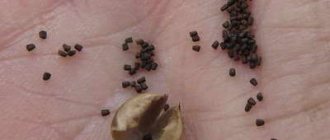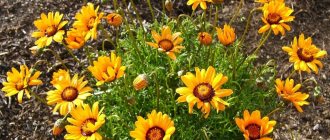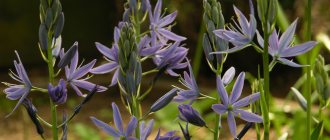Description of culture
On a note! This flower is very popular - they like to use it to decorate the landscape in home areas, flower beds, outdoor flowerpots, and are grown in flowerpots and on balconies.
The plant belongs to the Solanaceae family; petunia can be perennial or annual. But usually in Russia it is grown as an annual crop. It is unpretentious, easily takes root after transplantation, and tolerates both heat and moderate cold.
What does it look like
All specimens of this species stand out for their beauty:
- excellent growth - this species is usually no higher than 50 cm, the diameter of the bush is up to 30 cm;
- beautiful branching of shoots and greenery (foliage 5-10 cm);
Petunia
- are a bush-like form with a large number of flowers, funnel-shaped, all kinds of rainbow colors (from light shades to black velvet);
- The flower can be erect or creeping, and also large-flowered and multi-flowered.
Interesting: after flowering, petunia forms a small box with seeds in place of the flower, the number of which can reach up to 300 seeds.
Where does it grow
It is known that the petunia flower arrived in Europe and Russia from South America. In Brazil, a country where it is always warm, perennial petunia grows. In addition to Russia, petunia has conquered Europe and Asia with its appearance; growing this interesting flower is very popular here.
On what soils does it grow?
For petunia, you need to choose soil that contains a sufficient amount of nutrients and minerals. There is no need to take soil with a large amount of peat - this is not suitable for flower seeds. A universal soil is ideal for seedlings and flowers, as well as TerraVita - it is based on coconut fiber, which gives the soil lightness and breathability.
Planting petunia
You can prepare the soil yourself, at home, by combining sand, turf and peat in a 2:2:1 ratio. To disinfect the soil, you need to either pour boiling water on it or bake it in the oven. After two days, you can plant seedlings in it.
Is it possible to replant flowering petunia? Experts say: yes, this can be done and easily. It must be replanted directly with the soil. This method is called transshipment.
How does a plant reproduce?
On a note! Cultivation of petunia must begin with growing seedlings from seeds in February - March. The timing is determined depending on the location of the windows to the north or south.
Seeds need to be selected correctly:
- hanging varieties for pots and flowerpots, seedlings are regularly pinched;
- bush varieties for flower beds;
- if you choose pelleted seeds for sowing, you need to monitor the condition of the soil - it should always be moist, but ordinary seeds are not capricious;
- If you buy seeds from a mixture of varieties, it will be impossible to create compositions with flowers, since the palette will be unpredictable.
Once planted, the seeds will begin to germinate within a few days. After this, the sprouts desperately need sunlight; in its absence, it is better to turn on the lamps. As soon as the seedlings grow, they are immediately transplanted into separate cups. Proper picking of petunia is also necessary.
Petunia pick
Be sure to pick the petunia twice:
- for the first time when two leaves appear;
- the second - exactly a month after the first time.
Petunia can be transplanted into open ground as soon as each bush gets stronger and grows in separate cups. It is important to take weather conditions into account.
Important! Flowering begins four months after sowing the seeds with proper care.
Petunia also has one paradoxical difference. Many gardeners, getting to know this flower better, wondered: what is the difference between surfinia and petunia? The answer is very simple. In fact, hybrid surfinia does not propagate by seeds, but only vegetatively - by cuttings. And since surfinia is a perennial, it is quite easy for it to endure wintering; for this you need:
- in autumn, cut the mother bush to 20 cm and transplant into a 5 liter pot;
- keep it first on the veranda, then at home in a cool place;
- in March, uterine surfinia begins to wake up and grow, planting material grows faster and stronger;
- In April, prepare and plant cuttings; they will begin to bloom within a month.
Petunia Surfinia
Using perennial petunia in landscape design
The use of perennial petunia in decorating the garden and area near the house is very diverse. Due to its short growth, this flower is used to frame flower beds and garden paths. Hanging and cascading varieties of petunias look very beautiful in various wooden barrels and hanging flowerpots. Such flowerpots can be attached to trees or specially created supports.
Perennial petunia also serves as decoration for balconies and terraces.
Photo of perennial petunia in landscape design
You can more clearly see all the features of using this bright flower on the site in the presented photos.
Petunia is used to decorate balconies
To decorate flower beds
Perennial petunia in garden compositions
Perennial petunia is one of the most popular flowering plants in our gardens and balconies. Caring for it is quite simple, and the variety of varieties and colors will allow you to choose the right plants that will decorate your home, garden and plot.
Varieties and varieties
Zinnia - description, best varieties, annual or perennial
There are more than twenty species of wild petunia in the world, as well as seventy selected varieties. They all have differences.
The classification and description of varieties is as follows:
- Cascading - grows well to the sides, forming a lush, flowering bush. The stems are thick, the flowers are medium.
- Ampelous - creeping, long shoots with numerous flowers. More often they are planted in hanging pots for the effect of “blooming curtains”, or for the design of an “alpine slide”.
- Bush plants are not whimsical, they grow in the form of a bush, it is necessary to pinch the tops. Depending on the variety, the size of the flowers can reach 15 cm.
- Floribunda - it has many flowers (medium and large) up to 10 cm in diameter. It feels great in open ground, and is used for large plantings.
Petunia Floribunda
Petunias are divided into classes based on the diameter of the inflorescences:
- Grandiflora - petunia, the flowers of which are considered the most striking, flower size up to 16 cm;
- Multiflora - considered medium size, flower up to 6 cm;
- Milliflora - small flowers up to 4 cm and a small bush of the plant itself.
Milliflora
Among the cascade ones, the following varieties of petunias can be distinguished:
- Tornado is a variety with large flowers. The bush reaches 1.5 m, flowering is abundant and lasts until frost.
- Typhoon - characteristics are similar to Tornado, but can grow in open ground up to 2 square meters. m.
- Gioconda is the most popular among cascading petunias. The stems grow up to one meter, a huge number of flowers that begin to bloom very early. Feels great both in the ground and in flowerpots.
Petunia Gioconda
Ampelous petunias are also numerous in varieties, here are just a few:
- Surfinia petunia - tolerates bad weather remarkably well, blooms for a very long time with a huge abundance of flowers of different shades. But, unfortunately, this plant is difficult to find (the reason is propagation only by vegetative means).
- Avalanche is a popular variety, the length of the lashes is up to 70 cm, large flowers up to 10 cm. Various colors.
- Snow Queen - branches up to 80 cm long, numerous snow-white, shimmering flowers up to 10 cm and the finest aroma.
- Black velvet is a fascinating, unusual black flower that looks like velvet. Plant height up to 35 cm, large inflorescences up to 8 cm.
Black Petunia Black Velvet
There are also a huge variety of bush petunias:
- Pikoti is the most popular due to its unusual edging along the edge of the petals. The bushes grow up to 25 cm, the flowers are large, they bloom all summer until frost.
- Polaris is a new variety that is resistant to wind, heat and rain. It grows quickly up to 30 cm, blooms long and profusely.
Floribunda is distinguished by one of the best varieties called:
- Dormouse - gorgeous huge flowers, grows well in the sun and shade. The Sonya series consists of eleven hybrids. Sonya's favorite is the Orchid with contrasting veins on the petals.
On a note! There is also a wonderful Terry variety. It will immediately look different in a flowerbed; its flowers are large, corrugated, and resemble carnations. It also tolerates weather conditions well and blooms for a long time.
Cuttings
Another popular propagation method is to grow petunias from cuttings. To do this, in August, the most beautiful and strong mother plant is selected and transplanted into a container with a diameter of at least 15 cm. It is placed in a darkened room with a temperature from +10 °C to +12 °C. If there is no such room, then you can place the pot in the apartment. However, at elevated temperatures, the queen cell needs to be illuminated and watered to a minimum. Overwintering petunia does not look very healthy - the leaves droop, the plant seems to wither, as it is in hibernation. With the arrival of spring it begins to quickly come to life.
Before taking cuttings, the plant must be carefully examined for pests and diseases in order to obtain healthy planting material. In February you can start cuttings. To do this, apical sprouts measuring 10 cm are cut from the mother liquor. The top two leaves are cut in half, the rest are cut off completely. The lower cut should be powdered with Kornevin, then planted in cups, filling them with nutritious soil mixture. The cuttings should be placed at a depth of 4-5 cm (hydrogel can be added if desired).
The cups must be covered with polyethylene to prevent moisture evaporation. The seedlings are exposed to light and kept at a temperature from +20 °C to +24 °C. To stimulate rooting and development, it is recommended to spray twice a day, as well as install lighting with fluorescent lamps. Watering should only be done in the tray.
An important condition for growing petunias is sufficiently long lighting - plants need it for 14 hours a day. Roots usually appear after 5-7 days, and then leaves, so the film can already be removed. Subsequent care of seedlings is carried out in the standard way. If you continue to feed the mother plant with fertilizers, then after a while it will be possible to cut the grown cuttings again.
To prevent the seedlings from stretching out in length, but growing as a bush, experts advise when growing petunias in a flower bed or on a balcony to pinch 3-4 leaves, cutting off the top (the resulting cutting can also be rooted). After this procedure, the petunia grows into a thick bush; pinching can be repeated after 10-14 days.
About diseases and pests
Powdery mildew
Petunia Gioconda - variety description
Like any plant, petunia is susceptible to the following diseases:
- fungal diseases - powdery mildew, blackleg;
- pests - aphids, whiteflies, spider mites.
When fighting powdery mildew it is important:
- prevent flooding of flowers;
- separate infected flowers from healthy ones, remove the top layer of soil near the flowers, since the fungus lives there, and treat the plant with fungicides;
- Spraying with a solution will help: from 30 gr. soda ash with 5 gr. liquid soap into a small bucket of water.
Spraying petunia
The following drugs will help get rid of pests: Aktara and Taran. To avoid flower diseases, you need to take good care of them, create for them all the conditions for successful growth and flowering.
Features of caring for perennial petunia in the open ground
The further growth and flowering of your perennial petunia will directly depend on the constant and good care of this plant. It is attention to this bright flower that will allow you to admire its bloom until the cold weather.
Watering
Perennial petunia is a drought-resistant plant and can survive without water for a long time. However, this will certainly affect the brightness and splendor of flowering. Therefore, watering should be regular and moderate. Be sure to remember that you only need to water at the root to prevent water from getting on the delicate flowers. This can lead to their rotting. Petunia needs to be watered especially often in hot and dry summers.
Loosening and mulching
The next day after watering, you can loosen the soil around the plants and remove all weeds. This way you will avoid the appearance of a crust on the soil, which does not allow oxygen to reach the roots well. You need to loosen it very carefully so as not to damage the delicate stems of the petunia. After loosening, you can pour a layer of mulch around the bush. It is recommended to use dry peat or sawdust as mulch. Adding mulch will reduce the appearance of weeds and reduce moisture evaporation.
Feeding petunia
Perennial petunia responds very well to fertilizing. The splendor and duration of flowering essentially depend on their regularity. You can start feeding petunia already in the second week after planting the plant in open ground. As a fertilizer, it is best to use preparations with a high potassium content; complex fertilizers are also suitable. You can also use mullein infusion, which stimulates petunia flowering well. Alternatively, you can purchase special preparations for spraying petunias specifically. For example, “Kristalon green”, “Plantafol”. The frequency of fertilizing during the growing season and flowering of petunia is every 10 days.
Caring for petunia during flowering
During the abundant flowering of perennial petunias, it is very important to periodically remove dried buds. They can interfere with the lush flowering of the plant, and by removing them you will stimulate the active growth of new buds.
Pest Control
Perennial petunia has good hardiness, but if not properly cared for, the plant can develop various fungal and even viral diseases. Various pests may also appear on your flowers.
Petunia diseases:
- Late blight. This disease most often damages petunia. It appears as brown spots on the stems. After which they spread throughout the plant and it dies. Late blight can be combated with special antifungal drugs - fungicides. To prevent the occurrence of this disease, it is necessary to thin out petunia seedlings.
- Blackleg. This disease appears on the root stem and spreads throughout the plant. Signs: watery spots that subsequently darken. Control measures: fungicides for remaining plants. The damaged flower is removed along with a lump of earth.
- Gray rot. It appears as light brown spots, which are then covered with light fluff. After which the entire plant begins to die. Special preparations, fungicides, “Skor”, “Integral” help.
- Brown spot. The plant begins to turn yellow, and brown-rusty spots appear on the leaves. Copper-containing drugs help: Cartocid.
Pests:
- Spider mite. This little red spider appears on the underside of the leaves. In this case, the plant must be washed with a tobacco solution or special insecticide preparations.
- Aphid. Insects that settle on the underside of leaves and feed on plant sap. This causes the petunia to begin to dry out. To combat aphids, you can use a soap solution or nicotine sulfate preparation.
- Whitefly. Most often appears in closed greenhouses. To combat it, drugs containing permethrin are used.
Reasons why petunias don't bloom
For lush flowering, it is not enough to plant plants on time. There are a number of reasons why petunias do not feel well:
- nutrient imbalance. You should carefully read the instructions for using fertilizers. It’s better not to add a little than to overdo it;
- if the shoots have a dull, thinning appearance, then most likely there is not enough sunlight;
- improper watering regime can also cause the buds to drop.
Important! For abundant flowering, faded corollas should be removed.
When choosing a plant, you should take into account the style and design of the interior, and also pay attention to the color scheme. There can be several varieties in one container. Species of other flowers may also coexist, for example, fern, lobelia, hosta.
As a result of all this information, it becomes clear that ampelous petunias are quite unpretentious flowers that are characterized by long flowering. There is a large selection of varieties and varieties. This plant can be grown not only by professionals, but also by beginners in gardening.
Sowing seeds for seedlings
In order for petunia seedlings to grow strong and healthy, it is necessary, of course, to start from the ground. You can take ready-made store-bought soil, or you can prepare it yourself. This should be done in the fall. The soil should be loose and absorb moisture well.
It is best to use the following components:
- Garden land;
- Sand;
- Peat;
- Humus.
All components are taken in equal parts. Before use, the soil mixture must be heat treated and also disinfected using potassium permanganate.
The prepared soil should be placed in a mini greenhouse. It is best to use a plastic cake box or a five-liter bottle, cut lengthwise into two unequal parts. Moreover, there is no need to cut off the roof on one side.
Thoroughly moisten or place a layer of snow more than five centimeters thick on top. Place the seeds evenly on the snow. On white snow, black petunia seeds will be clearly visible, so you can monitor the density of planting.
If it gets too thick, the seeds can be moved using tweezers or a toothpick. After this, close the lid, or cover the container with film or glass. And leave your greenhouse alone in a warm place for about a week or 10 days.
Important! The mini greenhouse must be ventilated every day.
How to collect seeds
If you decide to collect petunia seeds, wait until they ripen on the bush. At the very beginning of flowering, mark out several lower buds on the petunia bushes of the varieties you want to sow next year, since in them the process of formation and ripening of seeds is faster. From the moment the buds form until the seeds fully ripen, about two months pass.
In the photo: Blooming variegated petunias
Petunia seeds are very small, their diameter is approximately 0.5 mm, there are about a hundred of them in a box. You can cut the seed pods and store them at home, but it is better to shake the seeds out of the pods, put them in bags and write on each of them the name of the variety and the year the seeds were collected. The seeds are ripened at room temperature for three to four months. When properly stored, petunia seeds do not lose their viability for up to four years.
- Which vines to choose for decorating a fence











